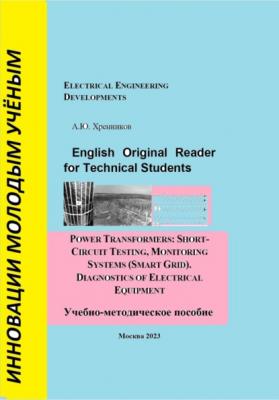English Original Reader for Technical Students. Power transformers: short-circuit testing, monitoring systems (Smart Grid). Александр Юрьевич Хренников
Читать онлайн.| Название | English Original Reader for Technical Students. Power transformers: short-circuit testing, monitoring systems (Smart Grid) |
|---|---|
| Автор произведения | Александр Юрьевич Хренников |
| Жанр | |
| Серия | |
| Издательство | |
| Год выпуска | 2022 |
| isbn |
Consider the work of the monitoring system in Figure 3 with an example of the 400 MVA/220 kV transformer testing. Current and voltage oscillograms at the second short-circuit shot on the phase «C» of the 400 MVA/220 kV transformer are shown in Figure 4.
Figure 4. Current oscillogram (1) and voltage oscillogram (2) in the second short-circuit shot on the phase «C» of the 400 MVA/220 kV transformer.
Current oscillogram analysis shows that the value of aperiodical (shock) component of short-circuit current at the beginning of the short-circuit shot amounted to 12.8 kA, and through 10 periods after attenuation of aperiodical (shock) component at the end of the shot, then periodic component is only 10.2 kA.
The calculated curve derivative from current and calculated inductance Ls-c curve of 400 MVA/220 kV transformer in the short-circuit shot on the phase «C» with 100 % of the value of the aperiodical (shock) short-circuit current are shown in Figure 5. Deviation of Ls-c amounted to +1.3 % in the short-circuit shot.
Figure 5. The calculated curve in the short-circuit shot on the phase «C» with 100 % of the value of the aperiodical (shock) short-circuit current of 400 MVA/220 kV transformer: a) derivative from current; b) calculated inductance Ls-c curve.
During the tests for withstands to short-circuit currents of 400 MVA/220 kV transformer, the following data were obtained:
values of voltage and current in short circuit shots,
the short-circuit inductance measurement results,
level of vibration in the short circuit shot,
LVI-testing data,
the results of chromatographic analysis of transformer oil dissolved gas (DGA).
Diagnostic data parameters allowed to complete the objective picture of the condition stste of 400 MVA/220 kV transformer during the tests for withstands to short-circuit currents [by 1–4].
1.6. An Accuracy of Diagnostic Parameter of Smart Grid Monitoring System
When Smart Grid Monitoring System is working, an important issue is the accuracy of main diagnostic parameter which characterizing the normal operation of power transformer – the short-circuit inductance of the windings. Large error during the measurement of this parameter can lead to malfunctions of the device: false outages or, on the contrary, the protection isn’t working when the inductance changed after the transformer or the reactor had been damaged. Therefore, it is proposed to introduce to the scheme of this device the block of the mathematical treatment of ΔL measurement.
The confidence interval of a random measurement error of transformer inductance was determined in the block of mathematical treatment of
Measured parameters I, U, P, F from the measured voltage transformers, capacitive voltage dividers, current-measurement shunts and frequency counter are input to the entrance of mathematical treatment block of measurement results, where at the entrance there are analog-to-digital converters (ADC), within which the following operations are performed by a special algorithm:
1) The value of short-circuit transformer inductance which is converted to a frequency 50 Hz, is calculated
Where Ii, Ui, Pi, Fi are the values of current, voltage, power and frequency which are measured by ADC during i- count.
2) The average value of short-circuit transformer inductance at the 50 Hertz frequency is calculated
together with the total average value, including the parameters of the I, U, P, F:
where: Xi – values of the I, U, P, F, measured by ADC during i-counting,
n is the number of measurements.
3) The deviation of short-circuit inductance is calculated
where:X0 – base value of short-circuit transformer inductance, determined by calculations according to the results of preliminary tests.
4) The root-mean-square deviation (RMSD) of the measurement results for each of the primary parameters of I, U, P, F is calculated;
5) The RMSD for the resultant of short-circuit inductance is calculated:
where:
where: I, U, P, F are the primary measured parameters of the current, voltage, power and frequency.
6) The value of the fourth central moment of distributing the random error of measurement of inductance X50 is calculated:
where n is number of measurements;
Xi50 is the value of short-circuit inductance;
Xaverage50 is the average value of short-circuit inductance;
7) The value of antikurtosis
where:
M4 is the value of the fourth central moment of distribution from (1.18).
8) The value of an entropy error of measurement is calculated:
where: n is the number of measurements;
d is the width of the interval of the histogram of distribution definition as:
where: Xi50 and Xaverage50 are the values from (1.12–1.14), moreover the maximum significance of a deviation between them is taken;
m is the optimum number of class intervals of columns for constructing the histogram of distribution law of the random error:
where
n is the number of measurements;
nj is the number of counting in j column of the histogram (j = 1…., m).
9) Determined by d – width of the interval of the histogram of distribution by (1.21);
10) Determined by m – optimum number of class
